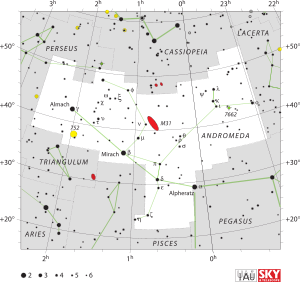Iota Andromedae
 | |
| Observation data Epoch J2000 Equinox J2000 | |
|---|---|
| Constellation | Andromeda |
| Right ascension | 23h 38m 08.20130s[1] |
| Declination | +43° 16′ 05.0649″[1] |
| Apparent magnitude (V) | +4.29[2] |
| Characteristics | |
| Spectral type | B8 V[3] |
| U−B color index | –0.29[4] |
| B−V color index | –0.11[4] |
| Astrometry | |
| Radial velocity (Rv) | –0.5[2] km/s |
| Proper motion (μ) | RA: +27.64[1] mas/yr Dec.: -1.02[1] mas/yr |
| Parallax (π) | 6.53 ± 0.16[1] mas |
| Distance | 500 ± 10 ly (153 ± 4 pc) |
| Absolute magnitude (MV) | −1.63[5] |
| Details | |
| Luminosity | 638[5] L☉ |
| Surface gravity (log g) | 3.35[6] cgs |
| Temperature | 12,620[7] K |
| Metallicity [Fe/H] | –0.19 ± 0.14[6] dex |
| Rotational velocity (v sin i) | 70[8] km/s |
| Other designations | |
| Database references | |
| SIMBAD | data |
Iota Andromedae (ι And, ι Andromedae) is a star in the constellation Andromeda. It has an apparent magnitude of +4.29[2] and is approximately 500 light years from Earth.[1]
Iota Andromedae is a B-type main sequence star with a stellar classification of B8 V. It is among the least variable stars observed during the Hipparcos mission.[6]
Name
- In the catalogue of stars in the Calendarium of Al Achsasi Al Mouakket, this star was designated Keff al-Salsalat (كف المسلسلة - kaf al-musalsala), which was translated into Latin as Manus Catenata, meaning palm of chained woman.[9]
- In Chinese, 螣蛇 (Téng Shé), meaning Flying Serpent, refers to an asterism consisting of ι Andromedae, α Lacertae, 4 Lacertae, π2 Cygni, π1 Cygni, HD 206267, ε Cephei, β Lacertae, σ Cassiopeiae, ρ Cassiopeiae, τ Cassiopeiae, AR Cassiopeiae, 9 Lacertae, 3 Andromedae, 7 Andromedae, 8 Andromedae, λ Andromedae, κ Andromedae and ψ Andromedae. Consequently, ι Andromedae itself is known as 螣蛇二十二 (Téng Shé èrshíèr, English: the Twenty Second Star of Flying Serpent).[10]
References
- 1 2 3 4 5 6 van Leeuwen, F. (November 2007), "Validation of the new Hipparcos reduction", Astronomy and Astrophysics, 474 (2): 653–664, arXiv:0708.1752, Bibcode:2007A&A...474..653V, doi:10.1051/0004-6361:20078357
- 1 2 3 Wielen, R.; et al. (1999), Sixth Catalogue of Fundamental Stars (FK6). Part I. Basic fundamental stars with direct solutions (35), Astronomisches Rechen-Institut Heidelberg, Bibcode:1999VeARI..35....1W.
- 1 2 "iot And -- Star", SIMBAD Astronomical Object Database, Centre de Données astronomiques de Strasbourg, retrieved 2012-06-19
- 1 2 Johnson, H. L.; et al. (1966), "UBVRIJKL photometry of the bright stars", Communications of the Lunar and Planetary Laboratory, 4 (99), Bibcode:1966CoLPL...4...99J
- 1 2 Anderson, E.; Francis, Ch. (2012), "XHIP: An extended hipparcos compilation", Astronomy Letters, 38 (5): 331, arXiv:1108.4971, Bibcode:2012AstL...38..331A, doi:10.1134/S1063773712050015.
- 1 2 3 Kocer, D.; et al. (August 2003), "Elemental abundance analyses with DAO spectrograms. XXVII. The superficially normal stars theta And (A2 IV), epsilon Del (B6 III), epsilon Aqr (A1.5 V), and iota And (B9 V)", Astronomy and Astrophysics, 406: 975–980, Bibcode:2003A&A...406..975K, doi:10.1051/0004-6361:20030620
- ↑ Zorec, J.; et al. (July 2009), "Fundamental parameters of B supergiants from the BCD system. I. Calibration of the (λ_1, D) parameters into Teff", Astronomy and Astrophysics, 501 (1): 297–320, arXiv:0903.5134, Bibcode:2009A&A...501..297Z, doi:10.1051/0004-6361/200811147
- ↑ Abt, Helmut A.; Levato, Hugo; Grosso, Monica (July 2002), "Rotational Velocities of B Stars", The Astrophysical Journal, 573 (1): 359–365, Bibcode:2002ApJ...573..359A, doi:10.1086/340590
- ↑ Knobel, E. B. (June 1895). "Al Achsasi Al Mouakket, on a catalogue of stars in the Calendarium of Mohammad Al Achsasi Al Mouakket". Monthly Notices of the Royal Astronomical Society. 55: 429. Bibcode:1895MNRAS..55..429K. doi:10.1093/mnras/55.8.429.
- ↑ (in Chinese) AEEA (Activities of Exhibition and Education in Astronomy) 天文教育資訊網 2006 年 7 月 7 日
This article is issued from
Wikipedia.
The text is licensed under Creative Commons - Attribution - Sharealike.
Additional terms may apply for the media files.